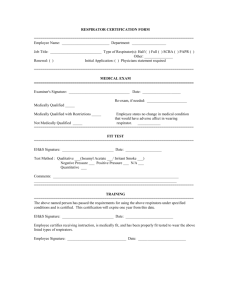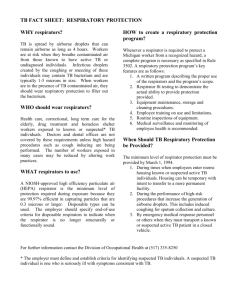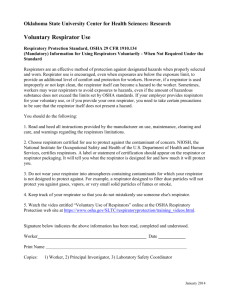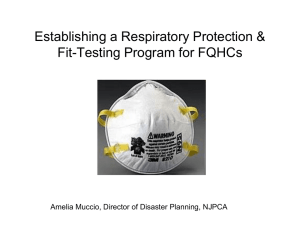X Main Heading
advertisement
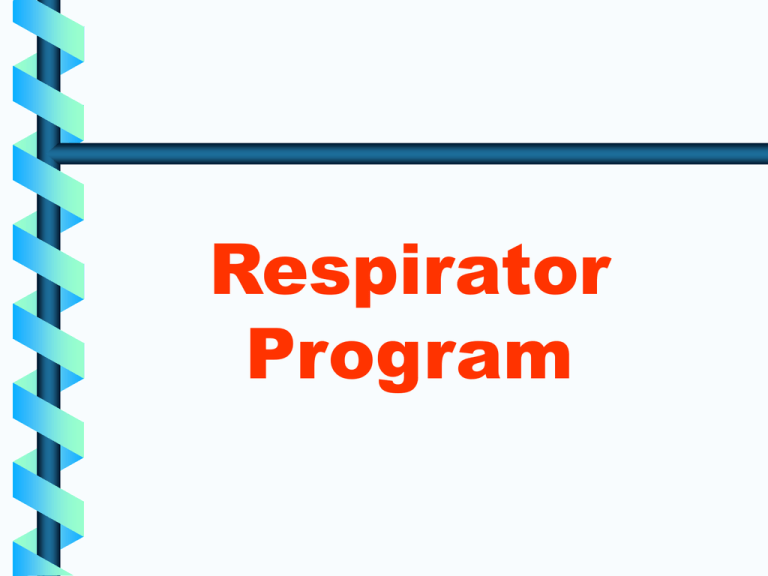
Respirator Program Training Outline • • • • • • • Terms and Regulation requirements What is a Respirator Program? Breathing hazards Types of respirators Fitting & checking respirators Inspection & care of respirators Medical limitations of using respirators Why Respirators Workers Must be Protected Who: – Are exposed to air contaminants (unknown or in excess of WCB OHS Reg.) – May be exposed to IDLH atmosphere – May be exposed to O2 deficient atmosphere – At risk of accidental exposure Terms Used • • • • • • • Airline respirator Air purifying respirator ALARA substance Canister or cartridge Escape respirator Fit check Fit test Terms Used - cont’d. • • • • • • • HEPA filter IDLH MSDS Sheet Oxygen deficiency Qualitative fit test Quantitative fit test SCBA The Respirator Program • • • • • Survey the workplace conditions Steps to reduce exposure Formally assess remaining hazards Select and provide respirators Provide fitting, tests, training Hazards & Risk Assessment • Determine the nature of contaminant • Determine exposure probability • Determine permissible exposure limit Respirator Selection • Is approved for contaminant • Can be used within concentrations expected • Will be adequate for time req’d. • Is the best choice for the workplace (heat, humidity, visibility, work mobility) Ensure adequate visibility The Breathing Hazards • Particle hazards (dusts, fibres, mists, fumes) • Gaseous hazards (gases and vapours) • Oxygen deficiency • Combination hazards Particle Hazards • Formed by breakdown of solids – – – – – – Sanding Milling Cutting Crushing Grinding Drilling • Irritate the airways, can cause disease – Asbestos – asbestosis – Silica dust - silicosis Mists • Very small liquid drops – Spraying – Shaking – Mixing – Stirring • Can irritate or damage exposed areas (skin, eyes, lungs, airways) • Can damage internal organs Fumes • Tiny solid particles (“boil off”) – Welding – Smelting – Soldering – Brazing • Exposure can range from irritation to serious lung & nerve damage Gaseous Hazards • Gases – Carbon Monoxide – Chlorine • Vapours of liquids – mix with air – Solvents – Gasoline – Acetone • Can enter blood – damage nerves and internal organs Oxygen Deficiency • Air is normally 21% O2 • 19.5 % O2 is required • Deficiency can develop in tanks, sewers, pipelines. • Oxygen depleted due to reaction (rot, rust, burning) • Oxygen is replaced by other gases Respirator Limitations • The type and the uses of Respirators are limited STRICTLY to the selection and uses determined by the [[Corporation]] Respirator Program • Specific hazards MUST be addressed by using ONLY the appropriate respirator Types of Respirators Air Purifying – Single Use – Half-face or Full-face Powered (air supplied) – Supplied air – Self-contained (SCBA) Air Purifying Respirators • Single Use • Half-face and Full-face air-purifying respirators (non-powered) Single Use Masks • Most commonly used • Only used against lower levels of contaminants • Thin filter with 2 straps • Must be formed around nose • Eventually clogged by dusts, mists, fumes Disposable Don’ts • Stretch the respirator over the top of a hardhat • Fold respirators that are not designed to be folded • Cut off straps • Wear damaged or holed respirators Half/Full Face Respirators • Close-seal silicone or rubber facepiece • One or more canister/cartridges • One-way valves • Half mask – covers nose, mouth and chin • Full mask – entire face covered Half/Full Face Respirators cont’d. • Half masks can be disposable or with maintenance/replacement parts • Full face masks are used where eye irritants may be present Filter Efficiency • Particulate filters screen particles only • Chemical cartridge efficiency deteriorates: – Smell or taste contaminates – Lungs or throat feel irritated – “End of Service” indicator Filter Don’ts • Don’t use in O2 deficiency • Don’t use against very toxic gas/vapour (IDLH atmospheres) • Don’t use against concentrations above manufacturer’s limits • Don’t use against chemicals with poor warning properties Filter Maintenance • • • • Store in sealed plastic bags Replace filters regularly Date filters as they are installed Match proper filter with the contaminant Atmosphere Supplying Respirators • Supplied-air (airline) respirators • Self-contained breathing apparatus (SCBA) Supplied Air Types • Hood or Helmet Airline Supplied – No face seal – No resistance to breathing • Full Face Airline Supplied – Face seal – Positive pressure minimizes leak Self-Contained Breathing Apparatus (SCBA) • Full-face respirator with backpack air cylinder – Fully mobile – Up to 60 minutes of air Emergency Respirators Escape Respirators • Used for emergency escape only • Must be carried or within immediate reach • Available as air purifying or air supply – “Bite-block” air supply are common in pulp mills – SCBA type with air bottle with half or full mask or hood Self-fit Checks & Fit Testing Negative Pressure Check • • • • • Don & properly fit the respirator Gently cover the inlet Breathe in to create a vacuum Hold for 10 seconds The facepiece should collapse slightly and STAY collapsed Positive Pressure Check • Don & properly fit the respirator • Gently cover the exhaust valve and breathe OUT slightly to bulge the facepiece • The facepiece should bulge and stay out for 10 seconds Cold Fit • Very low temperatures can stiffen mask material (lose sealing properties) • Allow time for material to flex • Allow the respirator to warm-up Fit Testing • Done by a qualified person • Results are documented • Qualitative fit test – Is a compound detected? • Quantitative fit test – Concentration inside/outside is compared Why Fit is Important • All contaminants MUST be excluded • Effective SEAL is essential • Facial hair must be clean shaven at the seal (including stubble) • Eyeglass frames must not pass through sealing surface (use corrective respirator lenses) Inspecting, Cleaning & Storing Respirators Respirator Inspection • • • • • • • Inspect prior to each use Bend and flex the respirator Look for distortion Check the yoke for cracks Check the canister threads Check for missing gaskets Check the inhalation valves Respirator Inspection cont’d. • Examine exhalation valve and seats for damage and debris • Check straps, harness, buckles • Check strap elasticity • Ensure cartridge is not expired • Examine canister for damage • Check the hose • Correct any defects that are noted Cleaning • Clean after each use, for a new user, or as required by the manufacturer • Remove: filters, cartridges and gaskets, head straps, demand and pressure valves, speaking diaphragms/equipment and any components recommended by manufacturer Cleaning - cont’d. • Discard any defective parts • Wash respirator components in warm water using mild detergent • NEVER use solvents • A brush may be used • Thoroughly rinse in warm, running water • Disinfect Cleaning - cont’d. • Rinse again to remove disinfectant and detergent • Drain all water and air dry (wiping with clean lint-free cloth is OK) • Reassemble away from the cleaning area Respirator Storage • Store in a safe place (cabinet, locker) in its own storage container • Do not store with tools • Position so facepiece, hoses and straps are not stretched • Store in a plastic bag • Seal HEPA filters with tape prior to removing • Avoid heat or direct sunlight Medical Limitations Medical Factors • • • • • • Drug use, including alcohol History of breathing problems Breathing difficulty when exerting High blood pressure or heart disease Claustrophobia Use of medication with heart/lung side effects or lowered mental alertness Medical Factors - cont’d. • • • • Diabetes Epilepsy Some vision or skin problems Impaired or non-existent sense of smell • Physical factors limiting donning or adjustment of respirator Consult OH Physician A physician knowledgeable in occupational health will be consulted Summary • • • • The Respirator Program Terms used Breathing hazards Selection, use, inspection, care and storage of respirators • Fit testing and cleaning procedures • Medical factors Questions?
